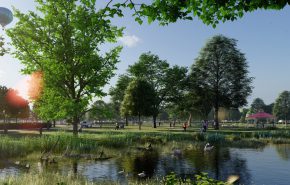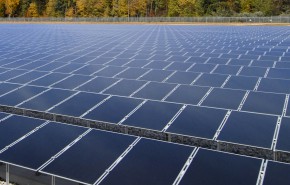While projections anticipate the continued rise in United States electricity demand, the nation is dependent on an outdated electrical grid to transmit and distribute power to homes and businesses. The U.S. Department of Energy reports that more than 70% of the grid’s transmission lines and transformers are more than 25 years old, creating vulnerabilities throughout the system. This year’s federal Building a Better Grid Initiative pledges support for a wide range of electrical infrastructure improvements and maintenance—and GAI’s Protection & Controls and Relay Setting teams deliver the services needed to create robust solutions in the specialized area of substation upgrade and development.
In this discussion, GAI’s Protection & Controls team leader Bob Steinmetz, PE, and Relay Setting & Technical team leader David Bierl, PE explore how their teams apply their knowledge to assist a range of clients with improving the uptime and ongoing safe operation of the substations that help deliver energy to homes and businesses throughout the United States.
Q: Please briefly describe Protection & Controls and Relay Setting and the functions they perform.
Bob Steinmetz: Substation protection & controls and relay settings work behind the scenes to monitor a facility’s performance and environment to help keep it online and operating efficiently and reliably. These components look for an array of possible faults within and outside the system in order to isolate such disruptions and mitigate possible negative effects these faults may have on the health of the substation as a whole. Taken together, these systems act much like a circuit breaker panel in a typical residence, which is filled with circuit breakers that trip off if they detect current exceeding the safe handling capacity of the home’s wiring. Substation protection & controls systems and relays are naturally more sophisticated than a home breaker panel, looking beyond current to monitor line impedance, current differentials, and much more.
GAI’s Protection & Controls (P&C) and Relay Setting teams design the schematics and wiring necessary to detail the way a piece of equipment will operate; they also provide the wiring diagrams needed to connect the devices into the existing or newly developed substation.
The U.S. power grid is outdated in many areas. The clients that come to us seeking to upgrade their substation capability to better meet demand are typically utilities that often don’t have the specialized expertise or staffing level to perform this sort of work in-house, and larger utilities are often eligible for substantial economic incentives from the federal government to help pay for outsourced work to upgrade or replace equipment.
Q: What sort of clients do GAI’S Protection & Controls and Relay Setting teams serve?
Bob: Much of our work is for electric utilities and municipalities, and we also serve a growing market of developers installing renewable wind and solar energy sources. We provide engineering services that go into the design of new substations and, more commonly, upgrades and equipment replacements for existing substations.
David Bierl: We are here to support a broad range of clients that are looking to have a robust substation designed, upgraded, and installed. For example, we worked with a mineral company that sought to run power to their mining site while exploring options for supporting the local community with power as well. Our clients have included co-ops, rural electric authorities wanting to branch into renewables, providers seeking to develop peaker generating stations that can mitigate fluctuations in electrical load and better serve demand spikes, and much more.
Q: What makes Protection & Controls and Relay Setting services important for GAI’s clients?
David: The U.S. power grid is outdated in many areas. The clients that come to us seeking to upgrade their substation capability to better meet demand are typically utilities that often don’t have the specialized expertise or staffing level to perform this sort of work in-house. Larger utilities are often eligible for substantial economic incentives from the federal government to help pay for outsourced work to upgrade or replace equipment. And smaller municipalities with a handful of substations may only have 10 people devoted to the facilities, many of them without the skills they need to tackle this sort of work. In either of these cases, we deliver the design, then instruct the client’s support staff on how everything operates and how to maintain it.
Bob: Our clients have an obligation to keep their customers’ power flowing with the fewest possible interruptions. Substations function as nodes within the electrical grid that enable the power created by generation facilities to be distributed to customers’ homes and businesses. Protection & Controls and Relay Setting help facilitate the substations’ operation at optimum service levels. In doing so, our work plays a vital role for our clients, their customers, and the overall integrity of the larger electrical grid that powers the nation.
That collaborative, cohesive team aspect that works so well for our clients also makes the experience of working at GAI continuously enjoyable, interesting, and engaging.
Q: What sort of GAI professionals take part in Protection & Controls and Relay Setting projects?
Bob: That’s a great question because the projects we work on are not typically tackled by a single person—they require an extended team with a range of skillsets. Project teams generally include senior and junior level electrical engineers, wiring designers, drafters, and project managers. We also count on a range of administrative support to help our projects run smoothly, including document control specialists, reprographics, accounting, and more.
David: At its core, the typical project team will include a substation physical layout engineer working with a substation Protection & Controls engineer. The substation physical engineer develops the technical specifications for the optimal equipment believed necessary for achieving the client’s goal, while the Protection & Controls engineer designs how that equipment will be integrated into the system along with the relays and auxiliary components necessary to operate the substation’s major equipment.
Q: How do you believe GAI provides enhanced value to clients seeking Protection & Controls and Relay Setting services?
David: What sets GAI apart from most is the fact that we’re a multidiscipline company—so when a client wants to develop a new substation or upgrade an existing facility, we have geotechnical, environmental, structural, transportation, and many other types of engineers and professionals who can address a broad range of possible project circumstances and requirements. Clients can come to GAI to handle a multifaceted project, and our diverse teams can collaborate on a cohesive project, which from the client’s perspective, is like working with a single entity.
Bob: David is correct, and he also really nails one of the reasons why I like working at GAI, which is being part of a coordinated team with a range of skillsets. That collaborative, cohesive team aspect that works so well for our clients also makes the experience of working at GAI continuously enjoyable, interesting, and engaging.
Contact Bob at 331.301.2004 or David at 517.435.3941 and find out more about GAI’s substation Protection & Controls and Relay Setting services—message GAI onlineand start the conversation about how our multidiscipline professionals can meet your unique project needs.
![]() Bob Steinmetz, PE has more than a decade of experience specializing in substation and P&C engineering projects. He has experience in a full range of substation projects from equipment replacement to large, intricate, multi-year substation expansions. At GAI, Bob manages an organization of engineers and designers on P&C, physical design, procurement, construction support, and project closeout. He is highly proficient in protection and controls specification.
Bob Steinmetz, PE has more than a decade of experience specializing in substation and P&C engineering projects. He has experience in a full range of substation projects from equipment replacement to large, intricate, multi-year substation expansions. At GAI, Bob manages an organization of engineers and designers on P&C, physical design, procurement, construction support, and project closeout. He is highly proficient in protection and controls specification.
![]() David Bierl, PE specializes in design engineering and project management. David currently leads a team of drafters, designers, and engineers in completing full substation design projects from conception to construction, ranging from simple replacement to complex multi-year projects. David is experienced in the wiring, programming, and troubleshooting of both electrical and mechanical systems. He is proficient in reverse engineering and root cause analysis.
David Bierl, PE specializes in design engineering and project management. David currently leads a team of drafters, designers, and engineers in completing full substation design projects from conception to construction, ranging from simple replacement to complex multi-year projects. David is experienced in the wiring, programming, and troubleshooting of both electrical and mechanical systems. He is proficient in reverse engineering and root cause analysis.


